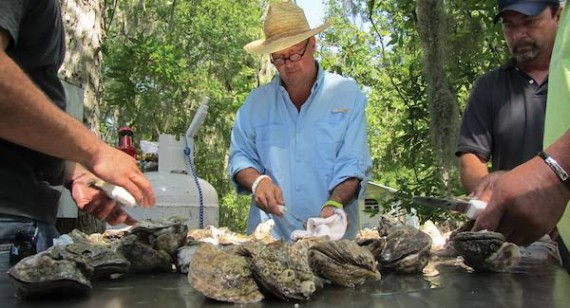
Andrew Zimmern of Bizarre Foods America shucks Louisiana oysters at a backyard crawfish boil in Bayou Pigeon. Photo courtesy of the Travel Channel.
Andrew Zimmern has yet to encounter a culinary specialty in Louisiana that he didn’t fall in love with. The region is known for its unusual fare compared to many other foodie destinations, but there isn’t much that shocks Zimmern’s taste buds. “I didn’t realize I would wind up making a show that was basically snuff film for picky eaters,” he says of his Travel Channel program, Bizarre Foods. The show features Zimmern traveling the world and trying local foods that the average American eater would never dream of ingesting. The new season, which debuts with its 100th episode on January 23, will come home and rediscover the bizarre foods of the U.S.
Zimmern visits Louisiana and New Orleans in an episode that airs January 30, 2012. “There’s no other place in the United States of America where if you say the name, you can taste the food, he says. “Los Angeles is a great city, but when I say that, you don’t taste it.” Although the food industry everywhere else tends to pull together, Zimmern sees a sense of camaraderie in New Orleans that he feels is unmatched and lends something to the spirit of the food community itself. “The spirit of the city hasn’t been bulldozed underneath a lot of other bullshit,” he says.
In Zimmern’s visits to the state, he’s found what many others have seen, that many food traditions remain unspoiled and are maintained in daily life. The local food culture of the region has never been pushed too far below the surface, which in this age of processing and factory farms is a testament to the active participation of food providers and consumers in the preservation of local culture. Zimmern has sat down for frog legs and sauce piquante cooked on open flame in Chef Donald Link’s family rice field in Mowata, Louisiana, and realized the rice he was eating was from last year’s crop out of that field, and the frogs were the ones he had caught the night beforehand. “The real Louisiana food culture from 50, 60, 100, 200 years ago is still available,” he says. “It just depends on how far you want to drive and where you want to see it. You just don’t get a chance to do that everywhere.”
Why has Louisiana’s food developed so definitively different from the rest of the country? Zimmern thinks New Orleans is like other cities that are similarly geographically situated that become melting pots for food techniques. Things tend to come and stay here as a result of visitors from all over the world, from South and Central America, the Caribbean Islands, China, Indonesia, from slave trade. All of these travelers influenced the food and took things away to incorporate into their own food traditions. Combined with those who came down on the Mississippi River from the north, there is a huge convergence of everything from French technique to backwoods smarts. “Soy sauce was a strange ingredient in 18th Century New York, but I would imagine if you opened up the occasional cupboard in small town Port Orleans, you would’ve without a doubt found soy sauce and curry powder,” he says. “New Orleans is one of those gorgeous repositories for those that are into food anthropology.”
That give and take means many dishes seemingly unique to Louisiana can be found in many different forms across the globe. One might wonder how different jambalaya really is from Spain’s paella, Italy’s risotto, South Asia’s biryani or West Africa’s jollof rice. Ponce is not only similar to Scottish haggis, but Zimmern discovered that the idea of organ meat cooked in a bladder crossed more cultures than he expected on a wildebeest hunt with tribal folk in Namibia. They chopped up some meat, eyeballs, ears, and pieces of liver, stuck it inside the stomach, poured ashes on top of it and put it in the fire to cook. “Flash forward and I’m in Mowata in a general store run by one of Don Link’s uncles, a man named Bubba Frey. He had one of the best versions of that dish. They’re eating boudin at Bubby Frey’s general store, and I show him Korean rice sausage, soondae. People in Korea can’t believe they’re doing that in Louisiana, and people in Louisiana can’t believe that’s one of the national dishes in Korea.”
That sentiment is at the heart of Zimmern’s show—to redefine the word “bizarre” and expand the American state of mind and taste palate. “I realized at a very early age that pickiness is relative,” he says. “I feel very strongly that in a world where we are always defining each other by our differences and often arguing with our tablemates, that we can celebrate the things we have in common. Food is a great way to do that.”




